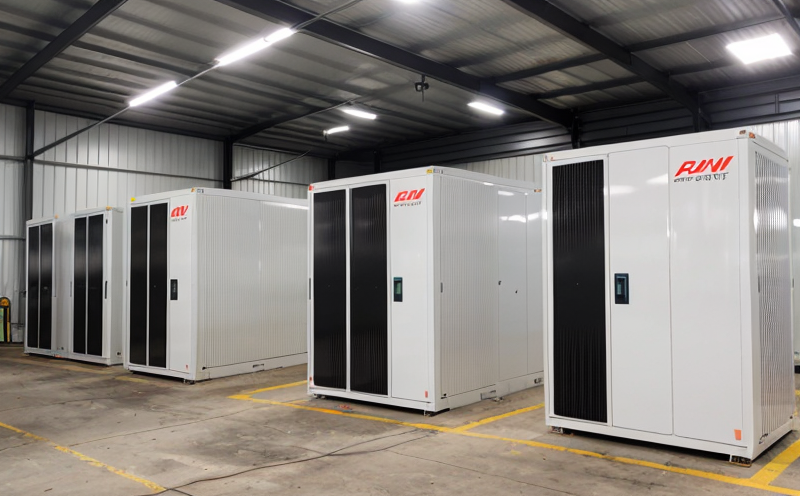ASTM D4169 Mechanical Shock Testing of Battery Packs
The ASTM D4169 standard is a critical component in ensuring the safety and reliability of battery packs used in various energy storage systems. This test evaluates how well a battery pack withstands mechanical shock, which can occur during transportation or installation. The importance of this testing cannot be overstated, as it directly impacts the performance and longevity of the battery pack.
During ASTM D4169 testing, the specimen is subjected to controlled mechanical shocks using a drop-weight device. This apparatus simulates real-world conditions where batteries might encounter sudden impacts or vibrations. The standard specifies precise parameters for the test setup, including the weight, height, and angle of the drop, as well as the acceptable limits for energy absorption by the battery pack.
The primary goal of ASTM D4169 testing is to ensure that the battery pack can withstand such shocks without compromising its structural integrity or electrical performance. Failure during this test indicates a potential risk in the field where the battery might fail under similar conditions, leading to safety hazards and potential environmental impacts.
The testing process involves several key steps:
- Setting up the specimen on a rigid support platform
- Positioning the drop-weight device
- Performing multiple drops from different angles to simulate various real-world scenarios
- Making detailed observations and recording data during and after each test
The results of ASTM D4169 testing are essential for quality managers, compliance officers, R&D engineers, and procurement teams. They provide critical insights into the durability and reliability of battery packs under mechanical shock conditions. This information is crucial for ensuring that products meet safety standards and perform reliably in challenging environments.
Compliance with ASTM D4169 not only ensures product quality but also helps companies avoid potential recalls, legal issues, and reputational damage. By adhering to this standard, manufacturers can demonstrate their commitment to safety and environmental responsibility, which is increasingly important in the energy sector.
Why It Matters
The importance of ASTM D4169 mechanical shock testing cannot be overstated. Mechanical shocks are a common occurrence during the transportation and installation of battery packs, especially for renewable energy systems used in remote or harsh environments. These impacts can lead to structural damage, electrical shorts, or even complete failure of the battery pack.
Failure during ASTM D4169 testing indicates that the battery pack may not be able to withstand real-world conditions, which could result in:
- Increased risk of product recalls
- Environmental damage due to improper disposal of damaged batteries
- Reputational damage and potential legal issues for the manufacturer
- Increased warranty costs and service downtime
To mitigate these risks, compliance with ASTM D4169 is essential. This standard provides a structured approach to testing that ensures consistent results across different manufacturers and regions. By adhering to this standard, companies can demonstrate their commitment to quality and safety, which is increasingly important in the global market.
Environmental and Sustainability Contributions
The ASTM D4169 mechanical shock testing plays a crucial role in promoting sustainability by ensuring that battery packs are robust enough to withstand environmental challenges. This resilience helps extend the lifespan of batteries, reducing the need for premature replacements and minimizing waste.
By improving the durability of battery packs through rigorous testing, manufacturers can contribute to:
- Reducing electronic waste
- Promoting recycling and repurposing of materials
- Lowering carbon emissions associated with production and disposal
- Enhancing overall energy efficiency in renewable systems
The testing process itself contributes to sustainability by providing valuable data that informs design improvements. This leads to the development of more resilient battery packs, which can operate efficiently even in challenging conditions. Ultimately, this reduces the environmental impact of energy storage solutions and supports broader sustainability goals.
Use Cases and Application Examples
| Use Case/Application Example | Description | ASTM D4169 Parameters |
|---|---|---|
| Renewable Energy Systems | Battery packs used in wind farms and solar power plants must withstand harsh environmental conditions. | Drop height: 0.5 to 2 meters; Angle of drop: ±45 degrees |
| Mobility Solutions | Batteries for electric vehicles (EVs) are subject to continuous vibration and impact during operation. | Drop angle: ±30 degrees; Multiple test runs with different drop heights |
| Backup Power Systems | Emergency power systems in remote locations require high durability against environmental shocks. | Drop height: 1 meter; Test duration: 24 hours post-test observation |
| Retrofitting Existing Infrastructure | Battery packs installed in existing buildings need to be tested for their ability to withstand installation-related impacts. | Customized drop tests based on specific site conditions |
| Hazardous Environments | Batteries used in mining and offshore operations must endure extreme environmental pressures. | Drop height: 1.5 meters; Test frequency: Quarterly for ongoing monitoring |
The ASTM D4169 testing process is versatile, allowing it to be applied across various industries where battery packs are used in critical applications. By adhering to this standard, manufacturers can ensure that their products meet the highest safety and performance standards, contributing to a more sustainable and reliable energy future.





